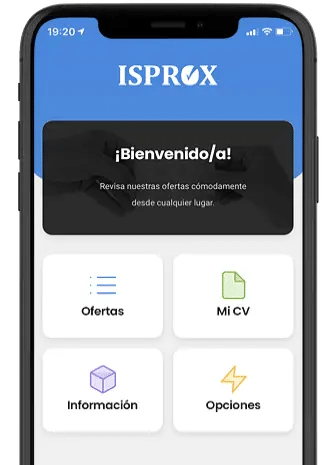Have you ever wondered which of the different types of CVs out there best suits you? The CV has evolved a lot, especially now with the digital era. That’s why there’s still a lot of questions every time we update it: what kind of photo should I include, do I include my age, what about my gender, what sections should I add, etc.? All this will always depend on your profile and what you want your CV to convey.
In addition to choosing a good style for your CV, it is also important to create your Personal Brand and be original, thus differentiating yourself from the rest of the candidates. As Viviana Giammatteo says in her book “Il curriculum creativo. Il CV e il Personal Branding nell’era del recruiting 2.0”, creating a Personal Brand is the only possible strategy to stand out and position yourself in the best way in today’s changing and competitive job market.
It is highly recommended to attach a cover letter to your CV. Keep in mind that 69% of human resources managers positively perceive attaching a personalised cover letter to your CV, as shown in the survey Cover Letters and Resumes carried out by The Society for Human Resources Management (SHRM).
Are you looking for a new job challenge?
Register your CV, and from ISPROX, we will contact you if any vacancy matches your profile.
The basics of creating your CV
When it comes to creating your CV, there are many options to choose from in order to catch the attention of the human resources manager and, thus, be able to stand out in any selection process in which you participate.
Among the many possibilities, you should always keep in mind the aspects that will make your potential stand out the most. For example, if you have just finished your studies, the style and structure of your CV should be different from the CV you would present if you had a long work experience.
Another aspect to take into account is the professional field in which you want to work, always bearing in mind the importance of Soft Skills, as including them in your CV will help you to highlight your human qualities and go beyond your experience and training.
Below, we show you several options to create your ideal CV and we explain when it would be better to choose one or the other. Let’s get started!

1. Chronological CV
With this style of CV, information is organised gradually, starting with the most recent achievements and jobs and ending with the older ones. This way, the human resources manager will be able to see the evolution of your career path. The chronological CV is very practical, as it allows a quick, clear and orderly view of the evolution of your career path.
There are two types of chronological CVs, depending on how the information is organised:
- Reverse chronological CV: The information is ordered from the most recent to the oldest. This is the most commonly used.
- Traditional chronological CV: In this case, the oldest information is prioritised.
This way of organising and structuring your CV is perfect if you have a long academic and professional career, as you will be able to show the evolution of your professional career in an orderly way, highlighting your promotions.
On the other hand, if you have had a period of inactivity at work or have changed jobs many times, we advise against using this type of CV.

2. Functional CV
The structure of the functional CV is based on the distribution of information by themes, highlighting your skills and competences, highlighting your achievements throughout your professional career and hiding or concealing information that does not work in your favour.
This style of CV is often used when you lack professional experience, as it allows you to highlight the skills and knowledge you have acquired so far. It is also advisable if you are an entrepreneur, as it allows you to make a compilation of the projects you have developed, regardless of when you carried them out.
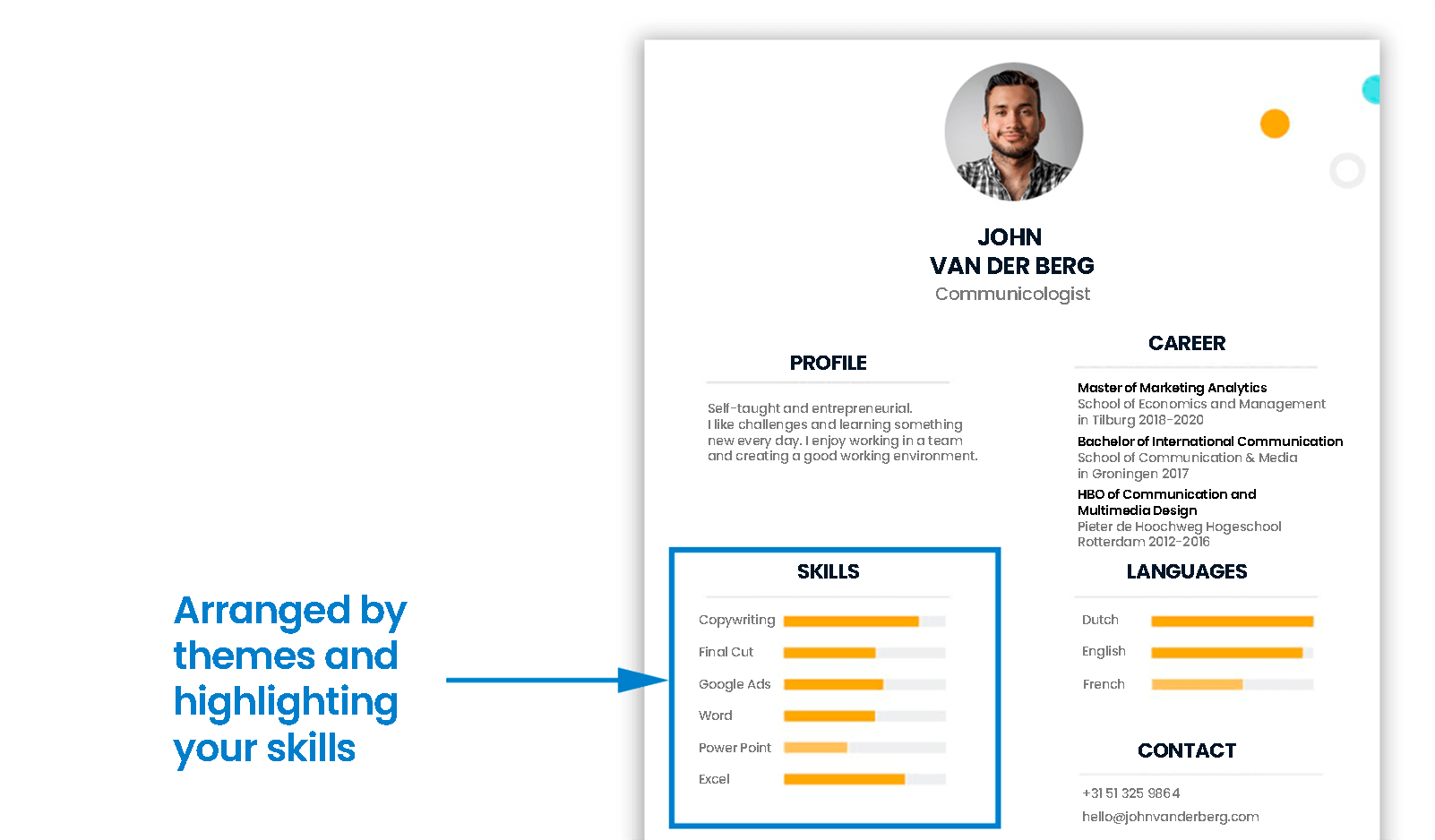
3. Combined curriculum
The combined CV is a mix between the chronological and the functional CV. This fusion of the two CVs allows you to highlight your professional evolution while highlighting your achievements and acquired skills.
This CV is very thorough, but also lengthy, so it is not advisable to use it if you have a very extensive professional career or if you have completed many courses or master’s degrees, as it may be too long. If you want to use it anyway, we advise you to filter it well and include only the information that best fits the requirements of the job you want to apply for.
Therefore, the functional CV is ideal for people who have a short career and want to include their skills and competences to make it even more complete.
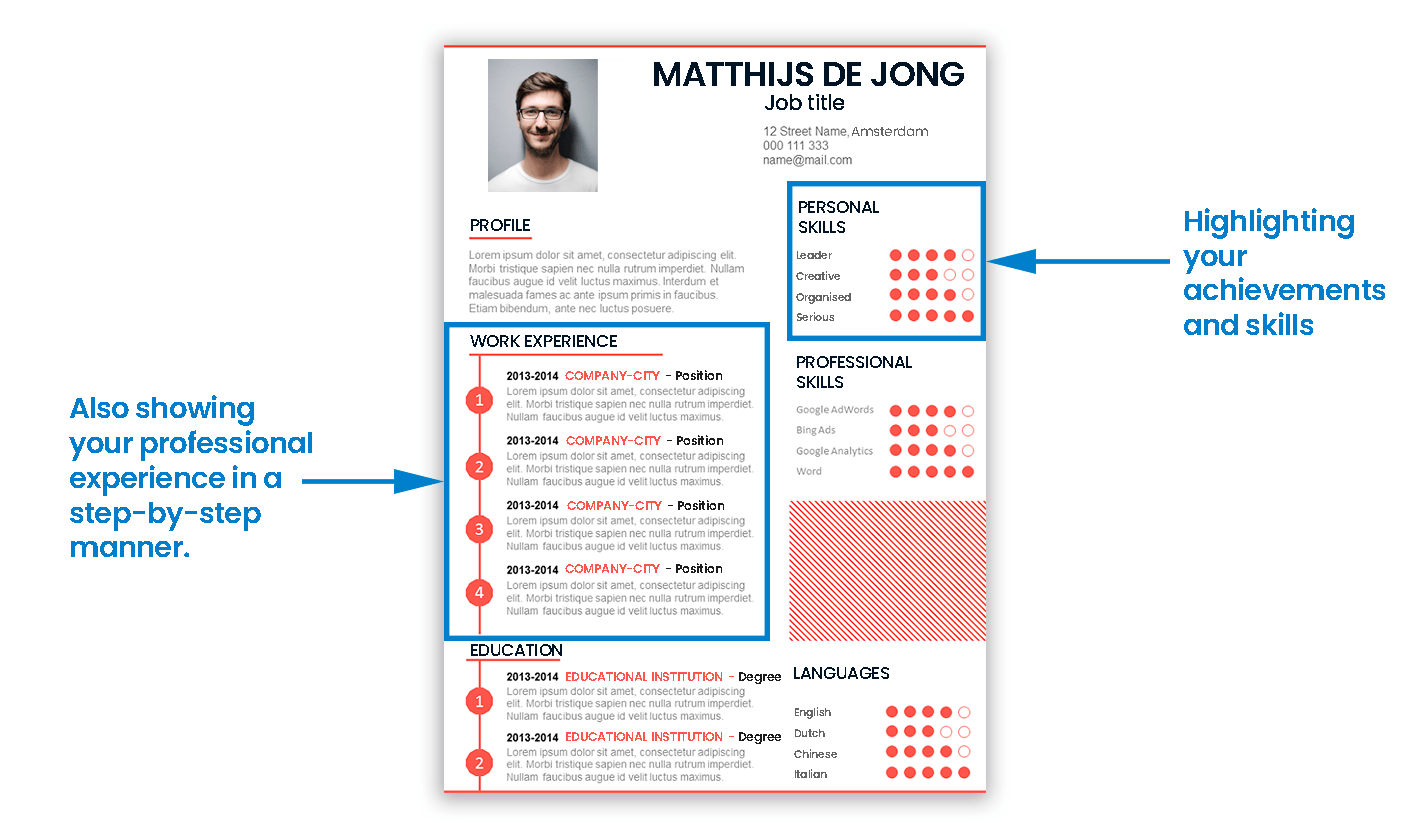
4. Creative CV
The creative CV is used to differentiate yourself, making it easier to catch the attention of the human resources manager, while demonstrating your creative skills. This type of CV does not just provide detailed information about your studies or experience, but also has an original visual element or a unique and personal way of organising the information.
There are many ways to create a creative CV, but the most important thing is to innovate and go for your own style, emphasising your skills. For example, if you are an illustrator, you could make a comic CV, showing your drawing style. On the other hand, if you are an international sales agent you could include an illustration of a map and mark the cities where you have closed sales.
We recommend including a QR code on your CV so that the recruiter can get a more in-depth look at your profile, for example, by downloading your conventional CV in chronological format or your portfolio, where they can see all your projects.
An alternative for easily designing a creative CV is PowerPoint. With this tool you can create hyperlinks to make your CV interactive and add images, shapes and graphics. You can then save your creation in PDF format.
Infographic CV or visual CV
An infographic CV is a very visual and concise CV, where the different sections are presented through graphics, images and short texts. The information you include should be concise enough to leave space for the visual elements, so before you start, do a planning exercise to be very clear about what you will include and how you will do it. Select the information that best fits your design idea and the job you want to get.
This style is very useful for people who want to apply for creative jobs such as graphic design or marketing, as you can demonstrate your skills through the design and content of the CV.
If you like the idea of creating an infographic CV, you can start doing it through one of these websites: Visually, Piktochart or Canva. If, on the other hand, you don’t want complications and you prefer a website that creates your infographic CV with the information you have on LinkedIn, you can use Visualize Me.
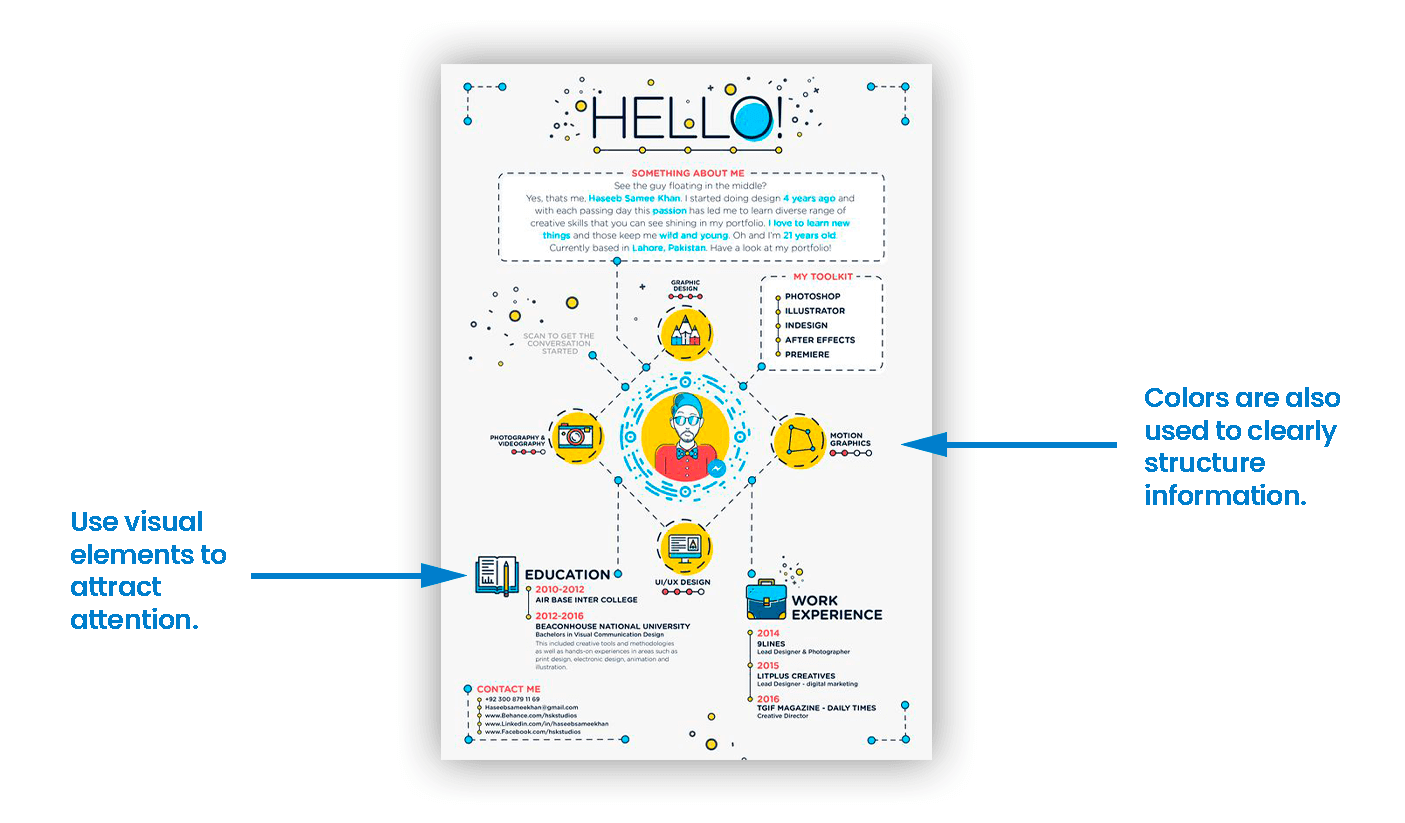
Comic CV
If you have a good command of design, drawing and animation techniques, this CV is perfect for you. Without a doubt, it is one of the most creative types of CVs, as you display all your professional information through a short illustrated story, which you can organise freely. You can do it in two ways:
- Illustrated vignettes:
Through a sequence of drawings, you can summarise where you come from and how far you have come, mentioning your training stage and your career path. Create a script with your story, add a touch of humour and make the human resources manager remember you for your originality.
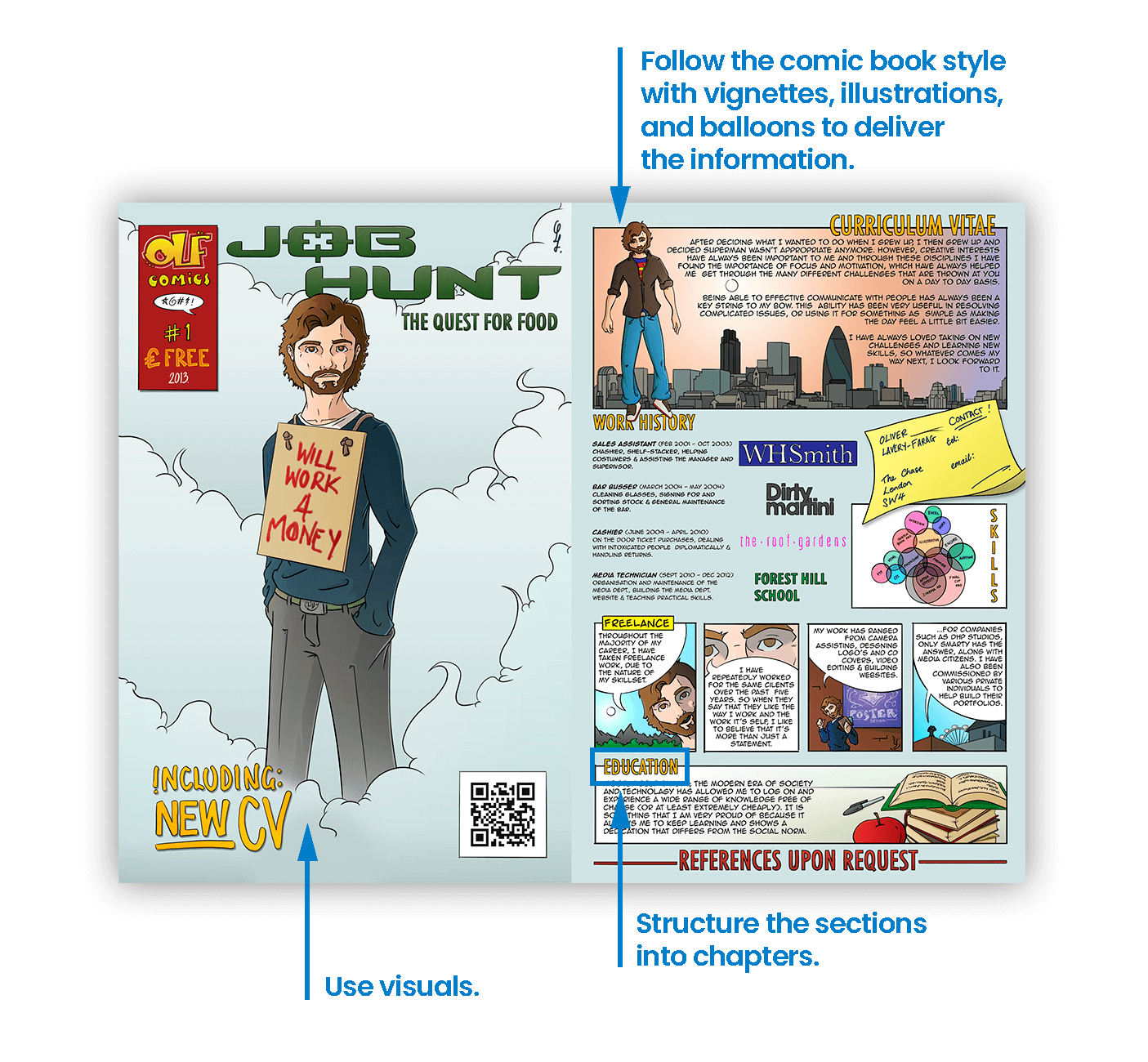
- Animation:
In this format you take on the role of the animated protagonist, explaining your skills and achievements through a short animated film, either in 2D or 3D (unless you want to find a job as a 3D animator, we recommend you to go for 2D to speed up the process). Creating a CV in this format requires a high level of proficiency in programming and animation techniques.
There are also some options for people who have no knowledge of animation, for example Animaker, a platform where you can create your animations from scratch, or from templates with a free version. In addition, this website already contains your animated characters and you can add text, music, your photos or videos. Other free platforms to make an animated video are Wideo or Educreations.
This candidate has decided to create her animated CV with the Animaker platform.
In this case, the candidate has used Motion Graphics. From illustrations and these graphics, he has created an animated resume.
Interactive CV
One of the most innovative CVs is the interactive CV, an eye-catching format where you can showcase your career in a participatory and online way. Interactive content is 81% more effective in capturing people’s attention, according to a study by Ion Interactive.
Moreover, with this type of curriculum you can be remembered more easily, since, according to data from the International Journal of Educational Technology in Higher Education, gamification and interactivity increase the retention of content by 12.23%.
Bear in mind that many of these CVs are only available for web pages, as they work like video games or are built with timelines. Therefore, it is advisable to also have a CV with a more conventional format.
To make an interactive CV you need some notions of programming or master programmes that allow you to add hyperlink buttons to make it participatory. If you don’t know how to get started, two tools that allow you to make this type of CV are Adobe’s InDesign or Genially.
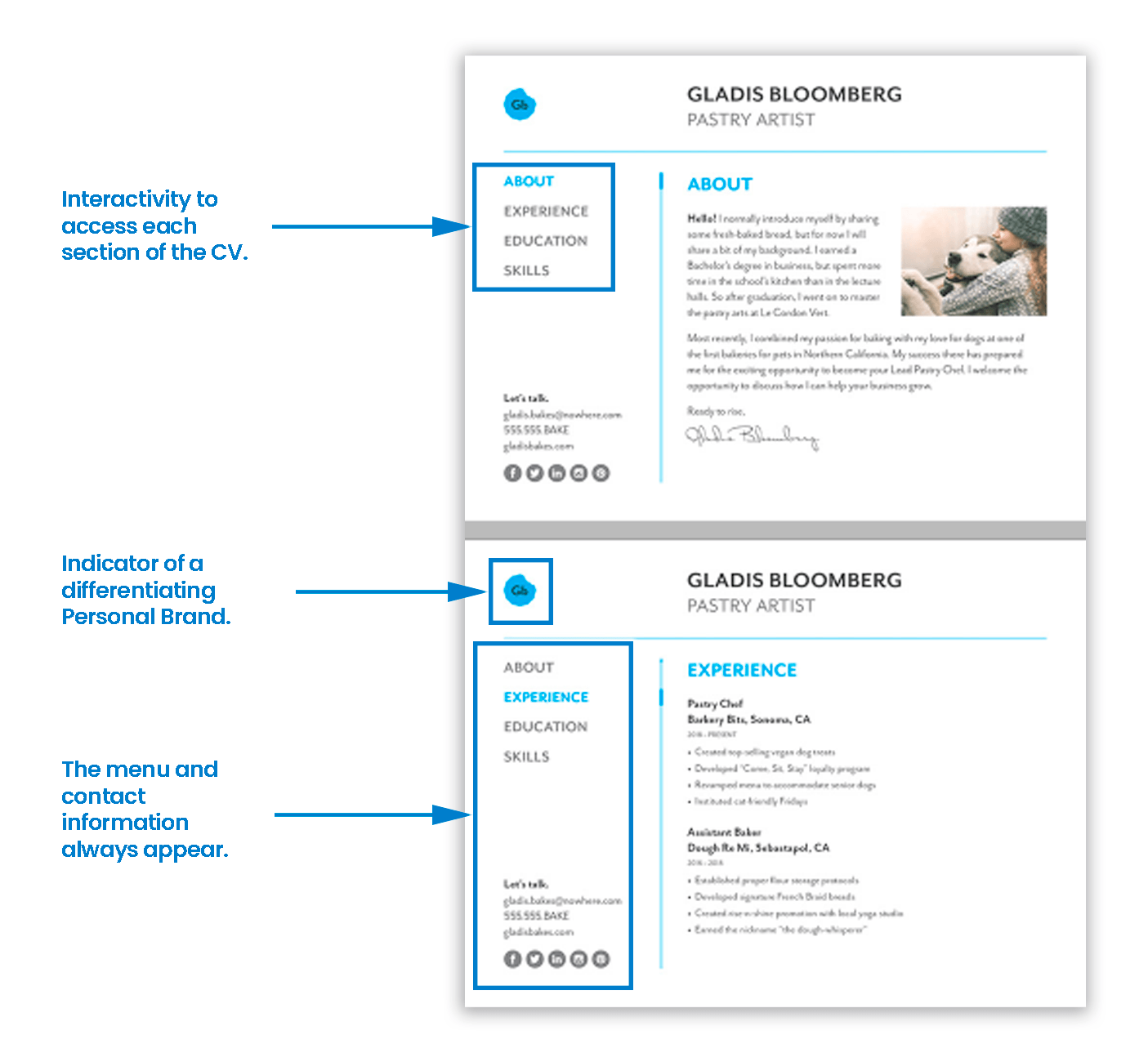
Creating your CV as a video game is a highly recommended option if you want to dedicate yourself to this world and you have programming skills. With this CV you can make yourself known, while demonstrating your creative and technical skills. Here we show you an example of a CV made as a video game. You will see that as the character passes through the screens, you will find all the information about the candidate. It is a very dynamic and fun option, where you can show all your potential and do something really unique and personal. It will be unlike anything else!
5. Video CV
If you want to make a very visual CV with many artistic and creative possibilities, the video CV is for you. This CV allows you to show your communication skills to potential employers, connect with them and convey your enthusiasm and personality right from the start. According to data from the ISCOD business school, a video CV increases a person’s chances of being hired by 35%.
You can play with both the format of the video and the subsequent editing, making your skills and values as a candidate known and emphasising those points that you want to highlight. The video CV lasts between 2 and 4 minutes, more or less, although
we recommend that your video CV does not exceed 2 minutes in length, as, after this time, attention starts to drop significantly, according to an analysis by SumoMe.
This CV is ideal for people who want to access a position related to the audiovisual world, but it can be just as effective in any other professional field. You can create your own video CV, explaining your career in first person and showing your projects in a visual way.
To create a video CV, you need to be clear about the aspects of your career and studies that you want to highlight, and, so as to have an order, you can create a short script, where you divide the content into sections. This outline will help you to structure the information and not forget anything. If you choose to record yourself speaking in front of the camera, it is not advisable to learn the script from head to toe, as this can make it seem forced. Try to speak spontaneously, taking the sections of the script as a reference.
For post-production or editing, you can use paid programmes such as Adobe Premiere Pro or free programmes such as Shotcut.
Here are some examples of creative video CVs:
This video CV is a clear example of the creative possibilities offered by this format. Here, the candidate uses creativity and humour in the right measure to explain his CV as if it were a story. He uses different cinematographic techniques to show himself in an office, freezing the movement on his face to reveal basic aspects such as his name, languages or place of birth
He then flashes back through his life to show how he got to where he is. The common thread he uses is the voice-over with background music that adds dynamism, and which, together with images and video resources, help to explain his entire career, languages, studies, skills, as well as personal aspects.
Another option of presenting your CV is to create an audiovisual piece outdoors with nature in the background. In this example, we can see how the protagonist looks directly at a fixed camera. The candidate speaks while the noise of the countryside can be heard, and is interspersed with noises and music when he wants to highlight a particular point that he is saying, which he also supports with graphic elements, such as the logos of the places where he has worked or a sample of his previous work,
ending with background music that goes in crescendo until he thanks the viewer for watching the video, mentioning his name. We have seen two examples with added creativity for more artistic job profiles, but for other job profiles, such as engineers or administrative staff, with much less creativity we can create a perfect video resume to attract employers.
With a camera and a bit of imagination, we can produce effective and engaging video CVs, as in the case of this example, where the candidate speaks in front of a screen showing their school and work experience, as well as tasks they can perform and skills they can bring to the job, ending with their contact details.
How do you know which type of CV is best suited to you?
This will always depend on your field of work, your knowledge and experience, your profile and what you want to show in your CV, as all the CVs we have shown you are equally valid. The only difference is in the format and the way the information is filtered, structured and presented.
The factors to consider when choosing the most suitable type of CV are mainly your education, your work experience, the projects you have carried out, and your skills, taking into account which are the most demanded skills for the new type of job.
Therefore, it is very important to consider all the requirements of the type of job you want to apply for, as well as the field you want to work in. For example, if you are a graphic designer, your CV should emphasise your graphic skills.
Remember that if you manage to attract attention through your CV, your chances of getting to the interview and getting the job you want will increase a lot, so don’t let your creativity go to waste!








